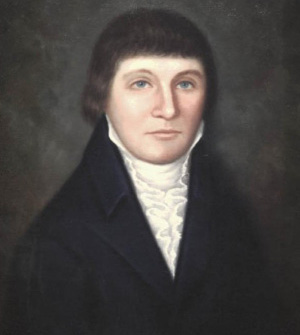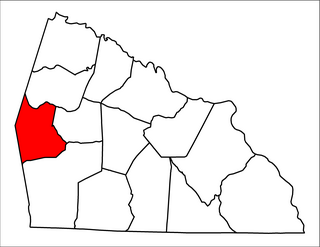
Warren County is a county located in the northeastern Piedmont region of the U.S. state of North Carolina, on the northern border with Virginia, made famous for a landfill and birthplace of the environmental justice movement. As of the 2020 census, its population was 18,642. Its county seat is Warrenton. It was a center of tobacco and cotton plantations, education, and later textile mills.

Vance County is a county located in the U.S. state of North Carolina. As of the 2020 census, the population was 42,578. Its county seat is Henderson.

Iredell County is a county located in the U.S. state of North Carolina. As of the 2020 census, the population was 186,693. Its county seat is Statesville, and its largest community is Mooresville. The county was formed in 1788, subtracted from Rowan County. It is named for James Iredell, one of the first justices of the Supreme Court. Iredell County is included in the Charlotte-Concord-Gastonia, NC-SC Metropolitan Statistical Area, as defined by the Office of Management and Budget, with data from the U.S. Census Bureau.

Oxford is a town in Granville County, North Carolina, United States, with a population of 8,628 as of the 2020 census. It is the county seat of Granville County.

Kittrell is a town in Vance County, North Carolina, United States.
John Williams, born in Surry County, North Carolina, was a Founding Father of the United States and signer of its Articles of Confederation. He was one of the founders of the University of North Carolina. During the American Revolutionary War, Williams was a colonel in the North Carolina militia. In 1777 and 1778, he was a member of the North Carolina House of Commons and served as speaker of the House. Williams was a member of the Continental Congress in 1778 and 1779.

Richard Caswell was an American politician and lawyer who served as the first and fifth governor of the U.S. state of North Carolina from 1776 to 1780 and from 1785 to 1787. He also served as a senior officer of militia in the Southern theater of the American Revolutionary War. As a delegate to the First Continental Congress, he was a signatory of the 1774 Continental Association.

The Province of North Carolina, originally known as Albemarle Province, was a proprietary colony and later royal colony of Great Britain that existed in North America from 1712 to 1776.(p. 80) It was one of the five Southern colonies and one of the thirteen American colonies. The monarch of Great Britain was represented by the Governor of North Carolina, until the colonies declared independence on July 4, 1776.

William Hawkins was the 17th governor of North Carolina from 1811 to 1814.

Robert Burton was an American farmer, Revolutionary War officer, and planter in what is now Vance County, North Carolina. He was a delegate from North Carolina to the Continental Congress in 1787. Between 1783 and 1815, the North Carolina General Assembly elected him to 13 one-year terms on the Council of State, which at the time was an official advisory panel that the legislature used to check the governor's power.

The North Carolina Line refers to North Carolina units within the Continental Army. The term "North Carolina Line" referred to the quota of infantry regiments assigned to North Carolina at various times by the Continental Congress. These, together with similar contingents from the other twelve states, formed the Continental Line. The concept was particularly important in relation to the promotion of commissioned officers. Officers of the Continental Army below the rank of brigadier general were ordinarily ineligible for promotion except in the line of their own state.
The Hillsborough District Brigade of militia was an administrative division of the North Carolina militia established on May 4, 1776. Brigadier General Thomas Person was the first commander. Companies from the eight regiments of the brigade were engaged in 55 known battles and skirmishes in North Carolina, South Carolina, and Georgia during the American Revolutionary War. It was active until the end of the war.

Richard Henderson was an American jurist, land speculator and politician who was best known for attempting to create the Transylvania Colony in frontier Kentucky. Henderson County and its seat Henderson, Kentucky are named for him. He also sold land to an early settlement that went on to become Nashville, Tennessee.

Mount Ulla Township is one of fourteen townships in Rowan County, North Carolina, United States. It is currently the smallest township in Rowan County by population.
Townsville is an unincorporated community in Townsville Township in northern Vance County, North Carolina, United States. It is located at the intersection of N.C. Highway 39 and Tungsten Mine Road, 13 miles (21 km) north of Henderson, at an elevation of 427 feet. Townesville was established in about 1821 and was part of Granville County until 1881 when Vance County was created. Townsville is near the John H. Kerr Reservoir and Virginia state line.
The Wilmington District Brigade was an administrative division of the North Carolina militia during the American Revolutionary War (1776–1783). This unit was established by the North Carolina Provincial Congress on May 4, 1776, and disbanded at the end of the war.
North Carolina state troops in the American Revolution were the initial military units created in a transition from the Province of North Carolina under British rule to independence from British rule. Most units did not last long as such and were either transferred to the Continental Army or state militia instead.
The North Carolina General Assembly of 1782 was the state legislature that first convened in Hillsborough, North Carolina, on April 15, 1782, and concluded on May 18, 1782. Members of the North Carolina Senate and the North Carolina House of Commons were elected by eligible North Carolina voters.
The North Carolina General Assembly of 1783 was the state legislature that convened in Hillsboro, North Carolina from April 18, 1783, to May 17, 1783. Members of the North Carolina Senate and the North Carolina House of Commons were elected by eligible North Carolina voters. This was the last assembly to meet during the American Revolution. Much of their time was devoted to taking care of the North Carolina soldiers that fought in the war.













